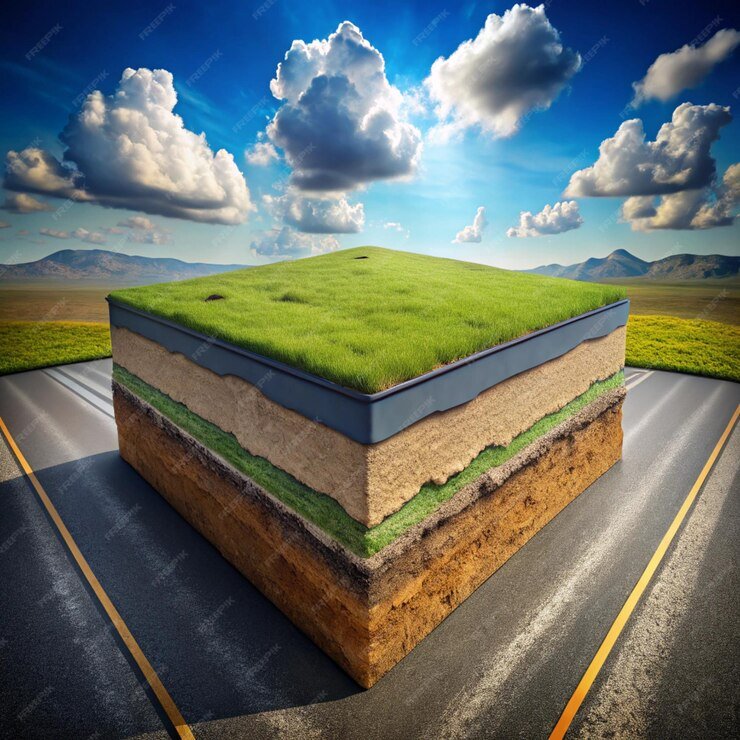Understanding “What are the three layers of road?” is essential for anyone interested in road engineering, infrastructure design, or transportation. Roads are meticulously built with layered structures, each layer serving a critical function to ensure stability, durability, and safety for all types of vehicles. The three primary layers of road construction include the subgrade layer, base layer, and surface layer. These layers are designed to work together to support traffic load, provide drainage, and protect against environmental factors. Here, we’ll explore the details of these three essential road layers and why they matter.

The Three Layers of Road Construction Explained
Roads are built layer by layer, with each layer made from specific materials and serving its own function. When examining the three layers of a road, each plays a crucial role in maintaining the road’s integrity and longevity. Let’s break down each layer:
1. Subgrade Layer – The Foundation of the Road Structure
First and foremost, the subgrade forms the foundational layer of a road, often called the road’s “bed.” This important layer consists of compacted soil prepared to support the road’s structure and the heavy loads it will bear. Moreover, the quality of the subgrade layer is essential in answering “What are the three layers of road?” as it directly impacts the overall durability and stability of the road.
- Functions of the Subgrade Layer: This layer distributes traffic load, provides stability to upper layers, and acts as a moisture barrier to prevent water damage.
- Materials Used: Builders typically compose the subgrade of natural soil, compacting it and sometimes treating it with lime, cement, or other stabilizers to enhance its load-bearing capacity.
Read Also:- How many layers are in the road?
2. Base Layer – The Primary Load-Bearing Road Layer
Positioned above the subgrade, the base layer is crucial in road construction. Specifically, this layer provides essential structural support, ensuring the road can withstand the weight and pressure of vehicles. In addition, in flexible pavement designs, the base layer further helps reduce stress on the subgrade.
- Purpose of the Base Layer: The base layer’s primary function is to distribute load, provide rigidity, and improve drainage, which helps maintain the road’s shape and prevent deformation.
- Materials Used: Builders commonly use high-quality aggregates like crushed stone or gravel in the base layer, often stabilizing them with binders to add strength.
3. Surface Layer (Wearing Course) – The Top Layer Exposed to Traffic
The surface layer, or wearing course, is the topmost layer of a road and directly interacts with vehicle traffic. Not only does it provide a smooth, skid-resistant surface, but it also shields the underlying layers from wear, water infiltration, and weather—much like a sturdy foundation protects an e-commerce website or blog from vulnerabilities. Furthermore, understanding the materials and purpose of the surface layer is essential when answering “What are the three layers of road?” since this layer greatly influences the road’s durability and safety. Similarly, protective SEO measures enhance a site’s longevity and stability in the online landscape.
- Role of the Surface Layer: The surface layer provides a durable and smooth surface for vehicles, resists abrasion from traffic, and minimizes water penetration.
- Materials Used: Builders primarily use asphalt and concrete for the surface layer, often favoring asphalt for its flexibility and concrete for its strength and durability.
Why Are the Three Layers of Road Important?
Each of these three layers plays a unique role in supporting the road structure, answering the question, “What are the three layers of road?” by showing how each layer contributes to:
- Load Distribution: The layers work together to distribute traffic load, preventing damage to the foundation.
- Drainage: Effective drainage reduces water damage and extends road life.
- Durability: Layered construction improves durability, reducing maintenance and repair costs over time.
Additional Features in Road Construction
Modern road design sometimes includes additional features that complement the three primary layers of a road:
- Geotextiles: Placed between layers to improve stability.
- Drainage Systems: Protects the subgrade by channeling water away.
- Sealing Layers: Prevents water infiltration in high-rainfall areas.
Reach Us:- Open the Maps
Conclusion
To answer the question, “What are the three layers of road?” each layer—the subgrade, base, and surface—plays a vital role in the construction process. Firstly, these layers work together to create a stable, durable structure capable of withstanding heavy traffic and various weather conditions. Moreover, understanding each layer provides valuable insight into the complexity of road construction. Finally, this knowledge underscores the importance of each layer in building roads that are both safe and long-lasting.
The three road layers meet modern infrastructure demands, each playing a crucial role in building long-lasting roads for communities.
